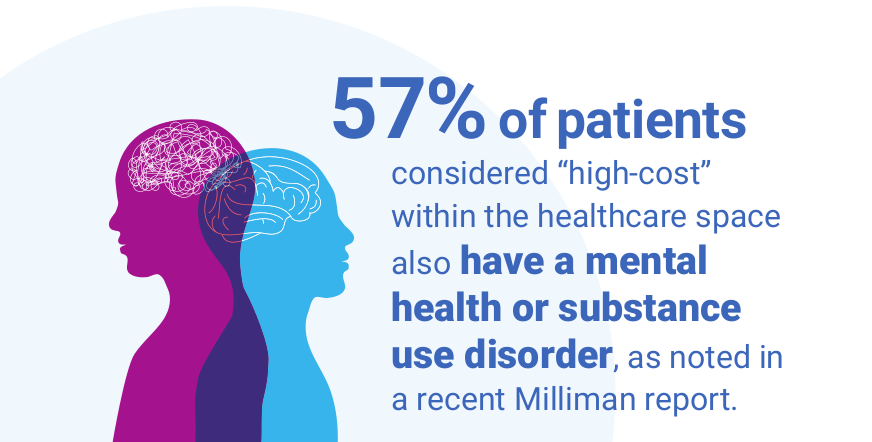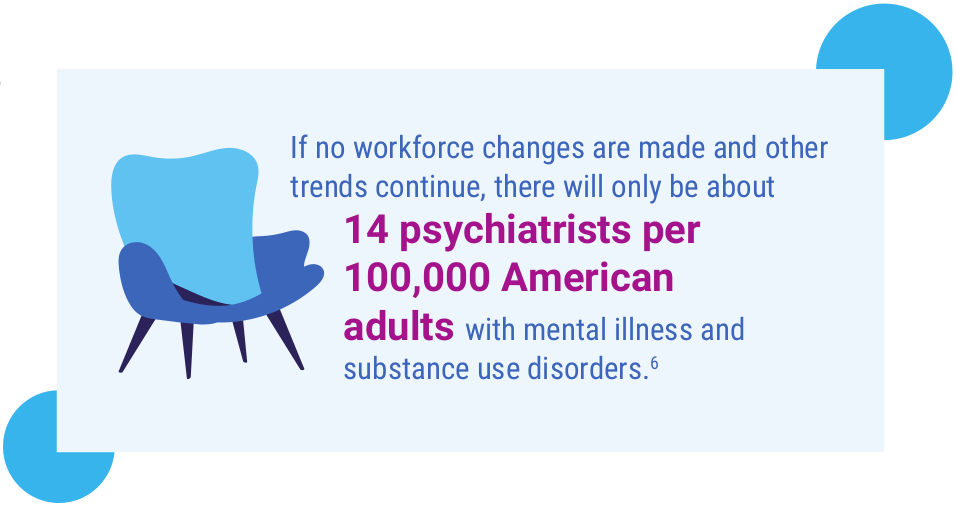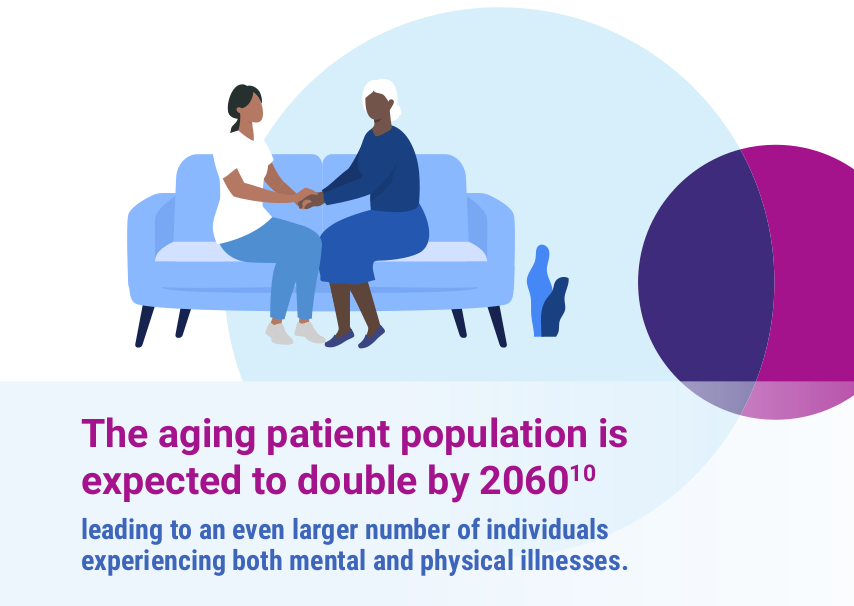By 2030, it is estimated that nearly 14 million Americans 56 years or older will have a mental health or substance use disorder – an increase of 57 percent from 2012.1 This growing number has pushed behavioral health to the forefront of hospital strategic priorities.

Research continues to highlight the benefits of a joint-venture or contract management partnership with a focused behavioral health expert for optimal patient and hospital outcomes. It also showcases the positive impact it can have on both physical and mental health conditions, as well as its ability to provide needed relief to emergency departments (EDs).2
This guide highlights three of the ways strategic joint-venture or contract management partnership can help streamline your hospital’s behavioral health offering to meet the needs of the aging patient population both now and in the future.
1. Length of Stay
When a patient is admitted to a hospital with both a physical and behavioral health illness, the likelihood of a prolonged length of stay (LOS) increases.3 For hospitals to address this issue, proactive integration of behavioral health services is critical, as LOS and bed occupancy are among the top indicators of care quality and outcomes. Prioritizing behavioral health integration can also help reduce psychotropic medication errors and improve patient satisfaction.4
An example of positive LOS outcomes following the introduction of behavioral health best practices is highlighted in a recent adult psychiatric ward study. The steps taken to achieve these outcomes include:5
- Involving existing hospital professionals in the process, and offering additional training and education. This strengthened their skill sets to better identify patients in need of behavioral health services.
- Utilizing an interdisciplinary team specifically trained in streamlining the care process and producing optimal behavioral health outcomes.
- Integrating pre-discharge communication with patients to identify potential issues that would lead to readmission or a failed discharge.
With guidance from a focused behavioral health expert, hospitals can more effectively integrate these best practices and resources. In doing so, results such as shorter LOS, reduced rehospitalization, lower care costs and improved patient satisfaction can be achieved.
2. Behavioral Health Staffing
The psychiatrist workforce shortage is projected to rise through 2024. If no workforce changes are made and other trends continue, there will only be about 14 psychiatrists per 100,000 American adults with mental illness and substance use disorders.6 However, the staffing shortage is not just limited to psychiatrists. Hospitals are facing shortages across the care continuum, hindering the delivery and efficiency of effective post-acute care.

These shortages are a major contributor to the current strain being placed on EDs. Patients in need of behavioral health services are turning to EDs, which are not properly equipped to identify and treat behavioral health conditions. This keeps patients from receiving prompt treatment and getting the care they need to recover – lowering patient satisfaction.
A partner with both local and national reach, in addition to experience identifying behavioral health talent, can help a hospital hire and retain staff that will provide exceptional behavioral healthcare. This will help alleviate ED capacity strains while increasing patient satisfaction.
Once the behavioral healthcare team is in place, identifying when and how they will be engaged in the patient care journey is an important next step. For instance, schizophrenia patients who had regular, favorable interactions with their psychiatric nurses throughout their care journey demonstrated improved treatment adherence and punctual attendance at appointments.7 The integration of behavioral health services as part of the overall care plan helped improve the patient’s overall health status and lowered the risk of readmission.
3. Operational Efficiencies
A recent Milliman report found that 57 percent of patients considered “high-cost” also had a mental health or substance use disorder.8 To reduce unnecessary medical spending and address the needs of the high-cost behavioral health patient population, hospitals are finding relief in a partner’s ability to improve efficiencies across the care continuum.
Areas of improved hospital efficiencies include:
Emergency Department Relief
When the appropriate behavioral health resources are deployed across care settings, ED capacity strains can begin to be lifted. Getting patients out of the ED and to the right level of care improves outcomes, helps the ED focus on patients in need of emergency treatment and allows the entire hospital to run more efficiently.
Improved Data Access and Sharing
A hospital’s ability to achieve better outcomes hinges on its access to the latest behavioral health data and its ability to apply these findings at the local level to enhance outcomes.9 The right partner will have access to best-in-class resources and data to help obtain and apply learnings for improved patient outcomes.
Technology Adoption
Increased technology utilization, such as wearable devices and telehealth services, can enable providers to better deliver preventive, personalized care solutions. Partnership can help hospitals gain access to the latest solutions without the heavy lift of developing from the ground up.
Partnership’s Role in Enhanced Adult Behavioral Healthcare
The aging patient population is expected to double by 2060.10 This will lead to an even larger number of individuals experiencing both mental and physical illnesses, requiring specialized care to effectively treat these co-occurring conditions. Through the guidance of a focused behavioral health expert, hospitals can begin to see improvements in their performance, leading to optimal outcomes within the geriatric patient population.

Lifepoint Behavioral Health is a leader in treating patients with mental health and substance use disorders through partnerships that integrate best practices, resources and innovative solutions – helping to produce high-quality care, streamlined operations and enhanced efficiencies.
References
- Bor, J. S. (2015, May 1). Among the elderly, many mental illnesses go undiagnosed: Health Affairs Journal. Health Affairs. Retrieved March 21, 2022, from https://www.healthaffairs.org/doi/10.1377/ hlthaff.2015.0314
- Behavioral Health Joint Ventures will continue to proliferate. The National Law Review. (2022, March). Retrieved March 21, 2022, from https://www.natlawreview.com/article/behavioral-healthjoint- ventures-will-continue-to-proliferate
- Sledge, W., Gueorguieva, R., Desan, P., Bozzo, J., Dorset, J., & Benjamin Lee, H. (2015). Multidisciplinary proactive psychiatric consultation service: Impact on length of stay for medical inpatients. Psychotherapy and psychosomatics. Retrieved March 8, 2022, from https://pubmed.ncbi.nlm.nih.gov/26022134/
- Benjenk, I., & Chen, J. (2018, September). Effective mental health interventions to reduce hospital readmission rates: A systematic review. Journal of hospital management and health policy. Retrieved March 8, 2022, from https://www.ncbi.nlm.nih.gov/pmc/articles/ PMC6167018/
- Adlington, K., Brown, J., Ralph, L., Clarke, A., Bhoyroo, T., Henderson, M., Boora, F., Aurelio, M., & Fawzi, W. (2018, November 1). Better Care: Reducing length of stay and bed occupancy on an older Adult Psychiatric Ward. BMJ open quality. Retrieved March 8, 2022, from https://www.ncbi.nlm.nih.gov/ pmc/articles/PMC6231107/
- Satiani, A., Niedermier, J., Satiani, B., & Svendsen, D. (2018, March 15). Projected workforce of psychiatrists in the United States: A population analysis. Psychiatric Services. Retrieved March 9, 2022, from https://ps.psychiatryonline.org/doi/10.1176/appi. ps.201700344
- Smithnaraseth, A., Seeherunwong, A., Panitrat, R., & Tipayamongkholgul, M. (2020, December 14). Hospital and patient factors influencing the health status among patients with schizophrenia, thirty days after hospital discharge: Multi-level analysis. BMC psychiatry. Retrieved March 11, 2022, from https://www.ncbi.nlm. nih.gov/pmc/articles/PMC7737347/
- Davenport, S., Gray, T. J., & Melek, S. (2020, August). How do individuals with behavioral health conditions contribute to physical and total healthcare spending? Milliman Research Report. https://www. milliman.com/-/media/milliman/pdfs/articles/milliman-high-costpatient- study-2020.ashx
- Judah, R., Allen, D. S., Rabinowitz, D., Piltch, M., & Karlinskaya, O. (2021). The Future of Behavioral Health. Deloitte Insights. Retrieved March 10, 2022, from https://www2.deloitte.com/us/en/ insights/industry/health-care/future-of-behavioral-health.html
- Substance Abuse and Mental Health Services Administration. (2019). Older Adults Living With Serious Mental Illness: The State of the Behavioral Health Workforce. https://store.samhsa.gov/sites/ default/files/d7/priv/pep19-olderadults-smi.pdf

